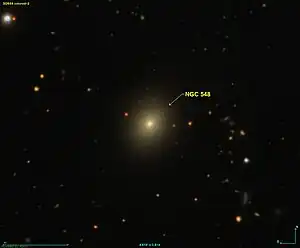| NGC 548 | |
|---|---|
 SDSS view of NGC 548 | |
| Observation data (J2000[1] epoch) | |
| Constellation | Cetus[2] |
| Right ascension | 01h 26m 02.5s[3] |
| Declination | −01° 13′ 32″[3] |
| Redshift | 0.01802 ± 0.00001[1] |
| Heliocentric radial velocity | (5354 ± 3) km/s[1] |
| Distance | 244 Mly[4] |
| Apparent magnitude (V) | 13.7[2] |
| Apparent magnitude (B) | 14.7[2] |
| Characteristics | |
| Type | E[2] |
| Apparent size (V) | 0.8' × 0.5'[2] |
| Other designations | |
| PGC 5326, UGC 1010, MGC +00-04-141, 2MASS J01260251-0113324 [1][5] | |
NGC 548, also occasionally referred to as PGC 5326 or UGC 1010, is an elliptical galaxy in the constellation Cetus.[2] It is located approximately 244 million light-years from the Solar System[4] and was discovered on 2 November 1867 by American astronomer George Mary Searle.[6]
Observation history
Searle discovered NGC 548 at Harvard Observatory using a 15" Merz refractor telescope. His given micrometric position also matches UGC 1010 and PGC 5326.[6]
See also
References
- 1 2 3 4 "NGC 548". Retrieved 2020-09-08.
- 1 2 3 4 5 6 "Revised NGC Data for NGC 548". spider.seds.org. Retrieved 2020-09-08.
- 1 2 "Your NED Search Results". ned.ipac.caltech.edu. Retrieved 2020-09-08.
- 1 2 An object's distance from Earth can be determined using Hubble's law: v=Ho is Hubble's constant (70±5 (km/s)/Mpc). The relative uncertainty Δd/d divided by the distance is equal to the sum of the relative uncertainties of the velocity and v=Ho
- ↑ "New General Catalog Objects: NGC 500 - 549". cseligman.com. Retrieved 2020-09-08.
- 1 2 "Adventures In Deep Space". Astronomy Mall. Retrieved 2020-09-13.
External links
Wikimedia Commons has media related to NGC 548.
- NGC 548 on WikiSky: DSS2, SDSS, GALEX, IRAS, Hydrogen α, X-Ray, Astrophoto, Sky Map, Articles and images
- SEDS
This article is issued from Wikipedia. The text is licensed under Creative Commons - Attribution - Sharealike. Additional terms may apply for the media files.